Download Pluto Worksheets
Click the button below to get instant access to these premium worksheets for use in the classroom or at a home.
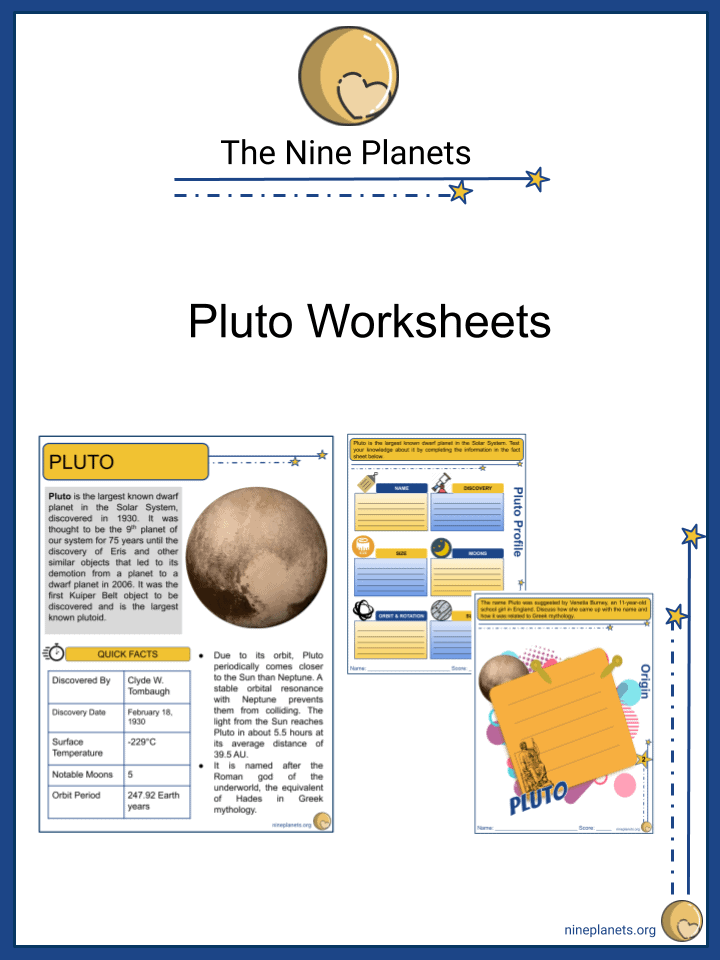
This worksheet can be edited by Premium members using the free Google Slides online software. Click the Edit button above to get started.
Download free sample
Not ready to purchase a subscription yet? Click here to download a FREE sample of this worksheet pack.
Resource Examples
Click any of the example images below to view a larger version.
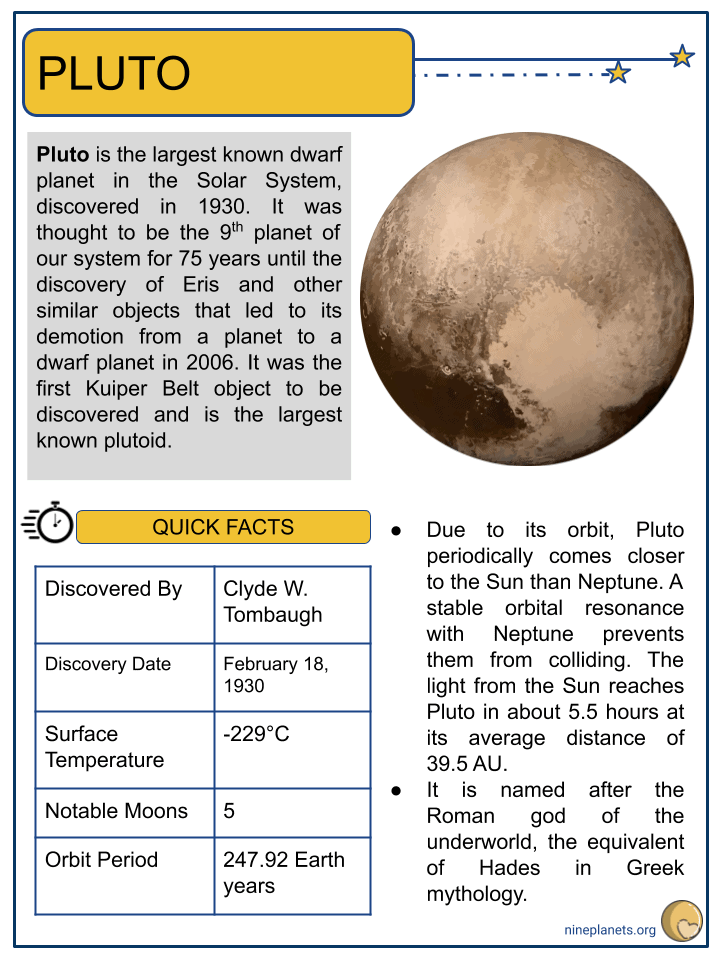
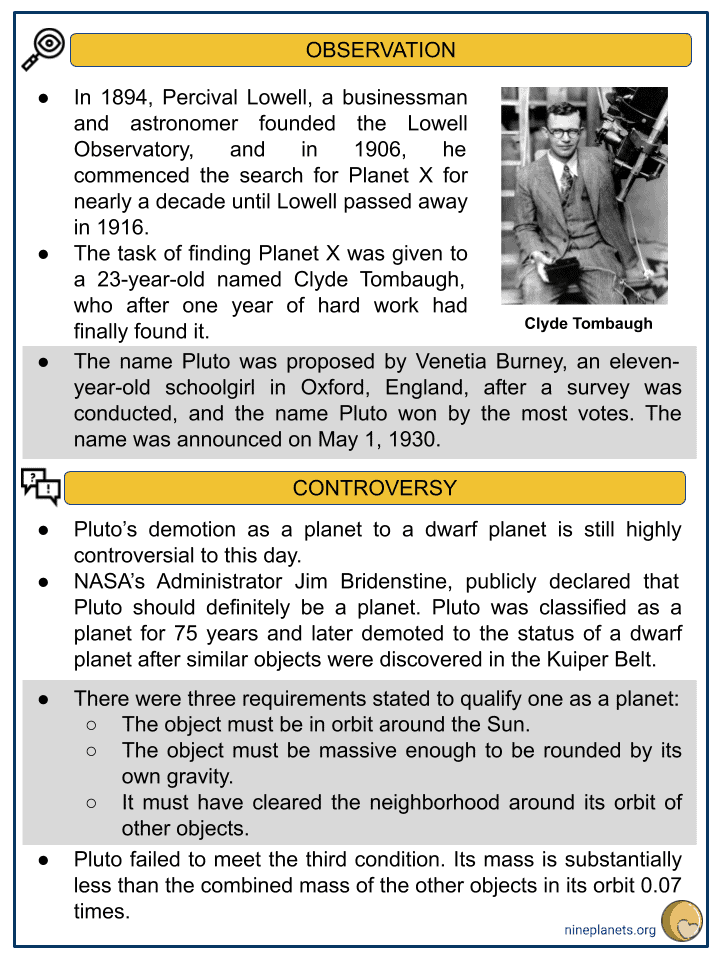
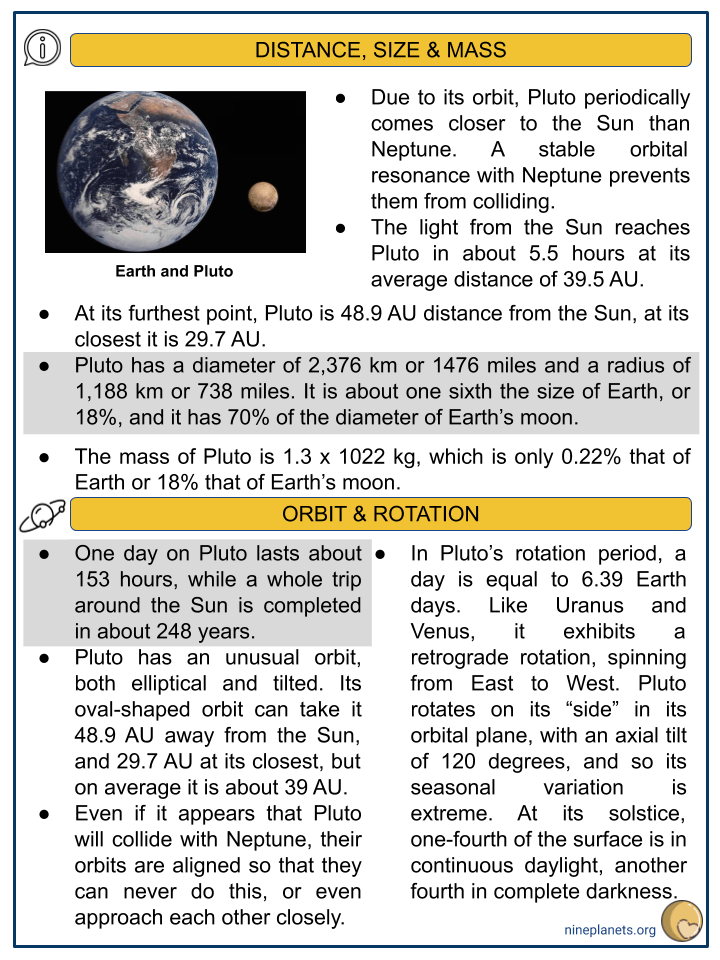
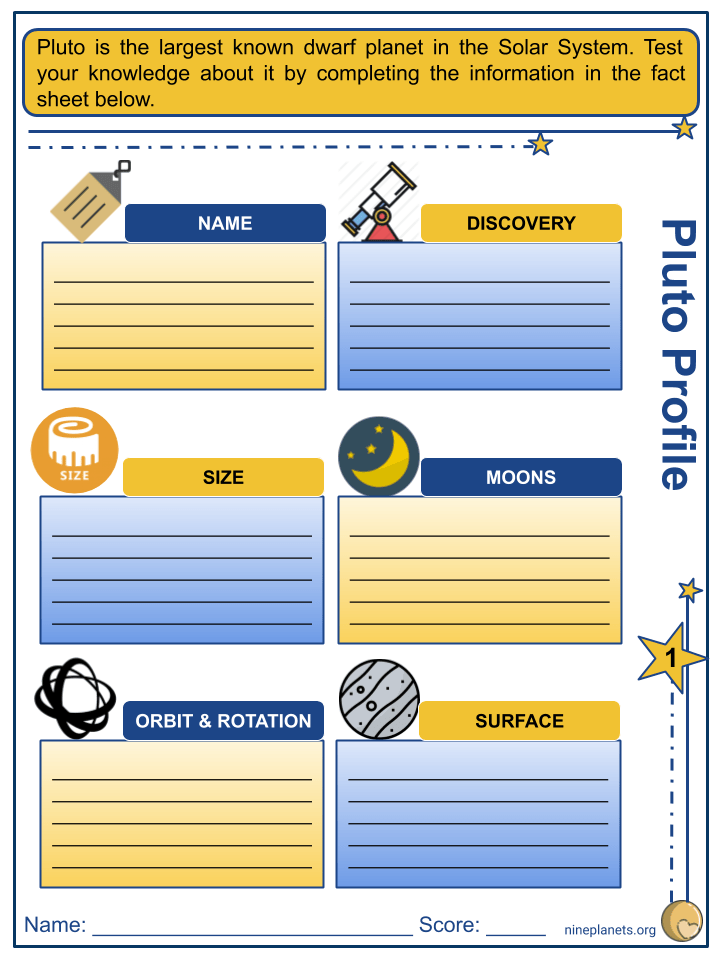
Key Facts & Information
- Pluto is the largest known dwarf planet in the Solar System, discovered in 1930. It was thought to be the 9th planet of our system for 75 years until the discovery of Eris and other similar objects that led to its demotion from a planet to a dwarf planet in 2006. It was the first Kuiper Belt object to be discovered and is the largest known plutoid.
Quick Facts
- Discovered By: Clyde W. Tombaugh
- Discovery Date: February 18, 1930
- Surface Temperature: -229°C
- Notable Moons: 5
- Orbit Period: 247.92 Earth years
- Due to its orbit, Pluto periodically comes closer to the Sun than Neptune. A stable orbital resonance with Neptune prevents them from colliding. The light from the Sun reaches Pluto in about 5.5 hours at its average distance of 39.5 AU.
- It is named after the Roman god of the underworld, the equivalent of Hades in Greek mythology.
Observation
- In 1894, Percival Lowell, a businessman and astronomer founded the Lowell Observatory, and in 1906, he commenced the search for Planet X for nearly a decade until Lowell passed away in 1916.
- The task of finding Planet X was given to a 23-year-old named Clyde Tombaugh, who after one year of hard work had finally found it.
- The name Pluto was proposed by Venetia Burney, an eleven- year-old schoolgirl in Oxford, England, after a survey was conducted, and the name Pluto won by the most votes. The name was announced on May 1, 1930.
Controversy
- Pluto’s demotion as a planet to a dwarf planet is still highly controversial to this day.
- NASA’s Administrator Jim Bridenstine, publicly declared that Pluto should definitely be a planet. Pluto was classified as a planet for 75 years and later demoted to the status of a dwarf planet after similar objects were discovered in the Kuiper Belt.
- There were three requirements stated to qualify one as a planet:
- The object must be in orbit around the Sun.
- The object must be massive enough to be rounded by its own gravity.
- It must have cleared the neighborhood around its orbit of other objects.
- Pluto failed to meet the third condition. Its mass is substantially less than the combined mass of the other objects in its orbit 0.07 times.
Distance, Size & Mass
- Due to its orbit, Pluto periodically comes closer to the Sun than Neptune. A stable orbital resonance with Neptune prevents them from colliding.
- The light from the Sun reaches Pluto in about 5.5 hours at its average distance of 39.5 AU.
- At its furthest point, Pluto is 48.9 AU distance from the Sun, at its closest it is 29.7 AU.
- Pluto has a diameter of 2,376 km or 1476 miles and a radius of 1,188 km or 738 miles. It is about one sixth the size of Earth, or 18%, and it has 70% of the diameter of Earth’s moon.
- The mass of Pluto is 1.3 x 1022 kg, which is only 0.22% that of Earth or 18% that of Earth’s moon.
Orbit & Rotation
- One day on Pluto lasts about 153 hours, while a whole trip around the Sun is completed in about 248 years.
- Pluto has an unusual orbit, both elliptical and tilted. Its oval-shaped orbit can take it 48.9 AU away from the Sun, and 29.7 AU at its closest, but on average it is about 39 AU.
- Even if it appears that Pluto will collide with Neptune, their orbits are aligned so that they can never do this, or even approach each other closely.
- In Pluto’s rotation period, a day is equal to 6.39 Earth days. Like Uranus and Venus, it exhibits a retrograde rotation, spinning from East to West. Pluto rotates on its “side” in its orbital plane, with an axial tilt of 120 degrees, and so its seasonal variation is extreme. At its solstice, one-fourth of the surface is in continuous daylight, another fourth in complete darkness.
Geology, Structure & Atmosphere
- The surface of Pluto is composed mostly of about 98% nitrogen ice, with traces of methane and carbon monoxide. It has mountains covered in water ice and its surface is quite varied, with large differences in both brightness and color.
- The color of Pluto’s surface varies from charcoal black, dark orange and white. It is similar in color to Jupiter’s moon Io, but with a little more orange.
- Pluto’s density is 1.860±0.013 g/cm3 and has no magnetic field. Scientists expected that Pluto’s internal structure is differentiated, with the rocky material having settled into a dense core surrounded by a mantle of water ice.
- The atmosphere of Pluto is similar to that of a comet. It has a thin, tenuous atmosphere that expands when it comes closer to the Sun and collapses as it moves further away.
- When it approaches the Sun, its surface ices sublimate, changing from solid to gas, and rises to temporarily form a thin atmosphere.
- The tenuous atmosphere is consisting of nitrogen, methane, and carbon monoxide.
Moons
- Only five natural satellites have been discovered orbiting Pluto. It is believed that this moon system was formed after a collision with a body similar in size to Pluto, in the early history of the Solar System.
- Charon. It is Pluto’s largest moon with a mean radius of 606 km or 377 miles. It has about half the diameter of Pluto and also one-eighth of its mass, being the biggest known moon of a dwarf planet.
- Nix. It has a diameter of 49.8 km and was discovered along with Hydra in June 2005. It is the third moon of Pluto by distance. The reddish area on Nix is most likely due to an impact crater. Nix’s brightness is about 5,000 fainter than Pluto’s.
- Styx. It’s discovery was announced in 2012, it is the second satellite of Pluto by distance and the last discovered. It is approximately 9.9 miles across its longest dimension with an orbital period of 20.2 days.
- Kerberos. It is about 19 km in its longest dimension and was the fourth moon to be discovered. The double-lobed shape of Kerberos is likely formed by two smaller objects that merged. Its rotational period was about 5.33 days and its rotational axis was tilted about 96 degrees to its orbit.
- Hydra. The second largest moon of Pluto, with a diameter of about 51 km, slightly bigger than Nix. By distance, it is the fifth and outermost moon of Pluto, and has a highly reflective surface caused by the presence of water ice, similar to other Plutonian moons. It has an orbital period of approximately 38.2 days and is resonant with other moons of Pluto.